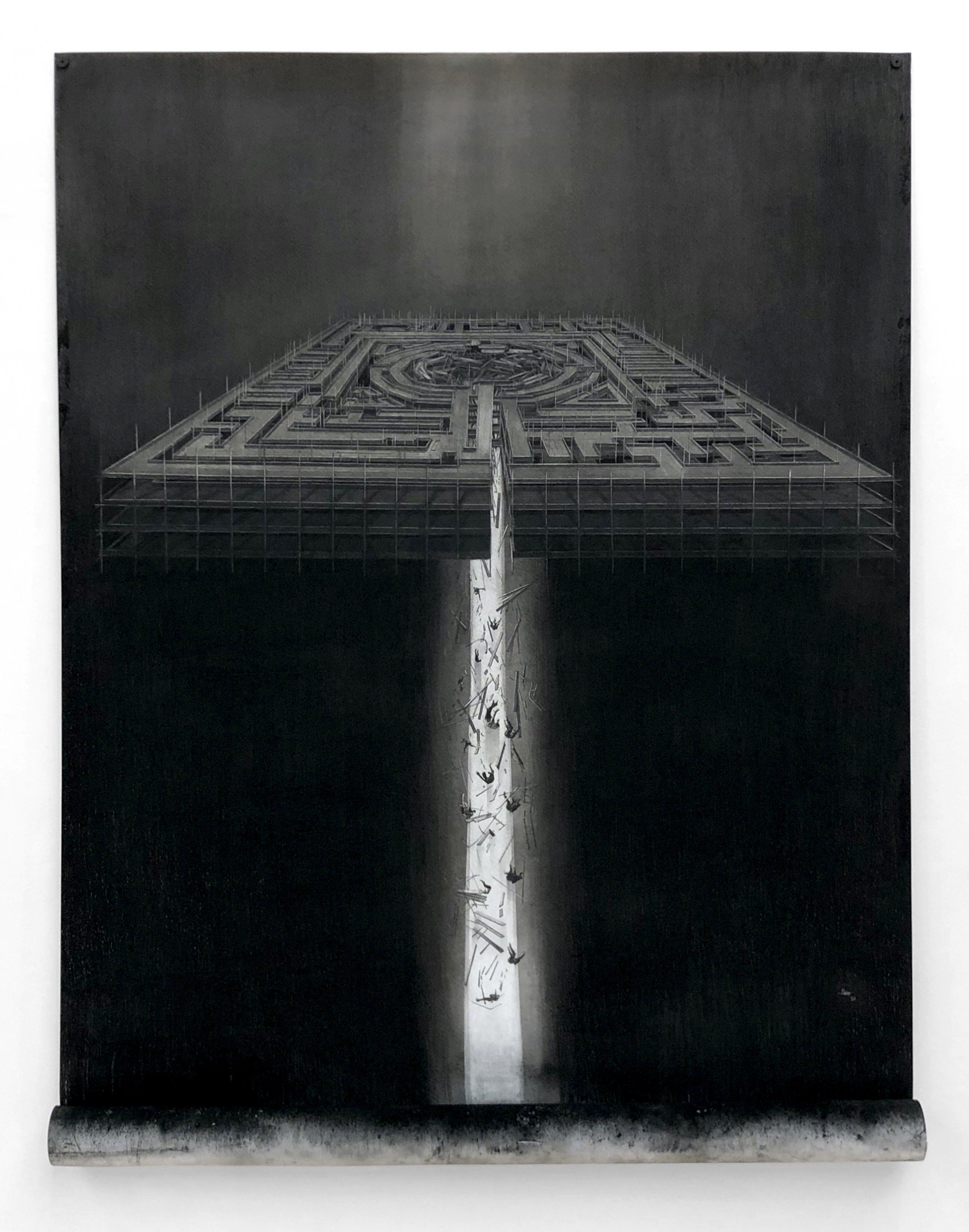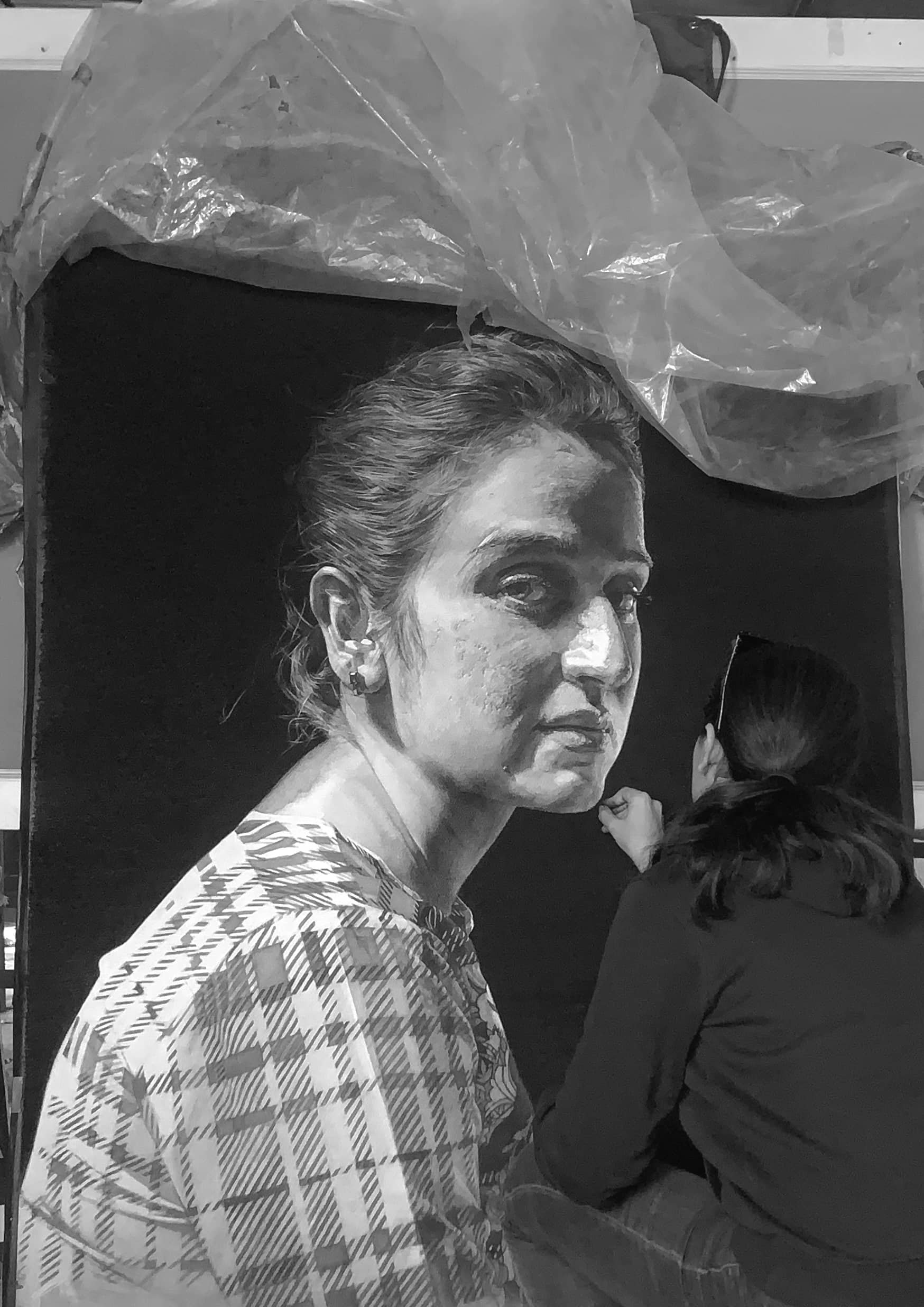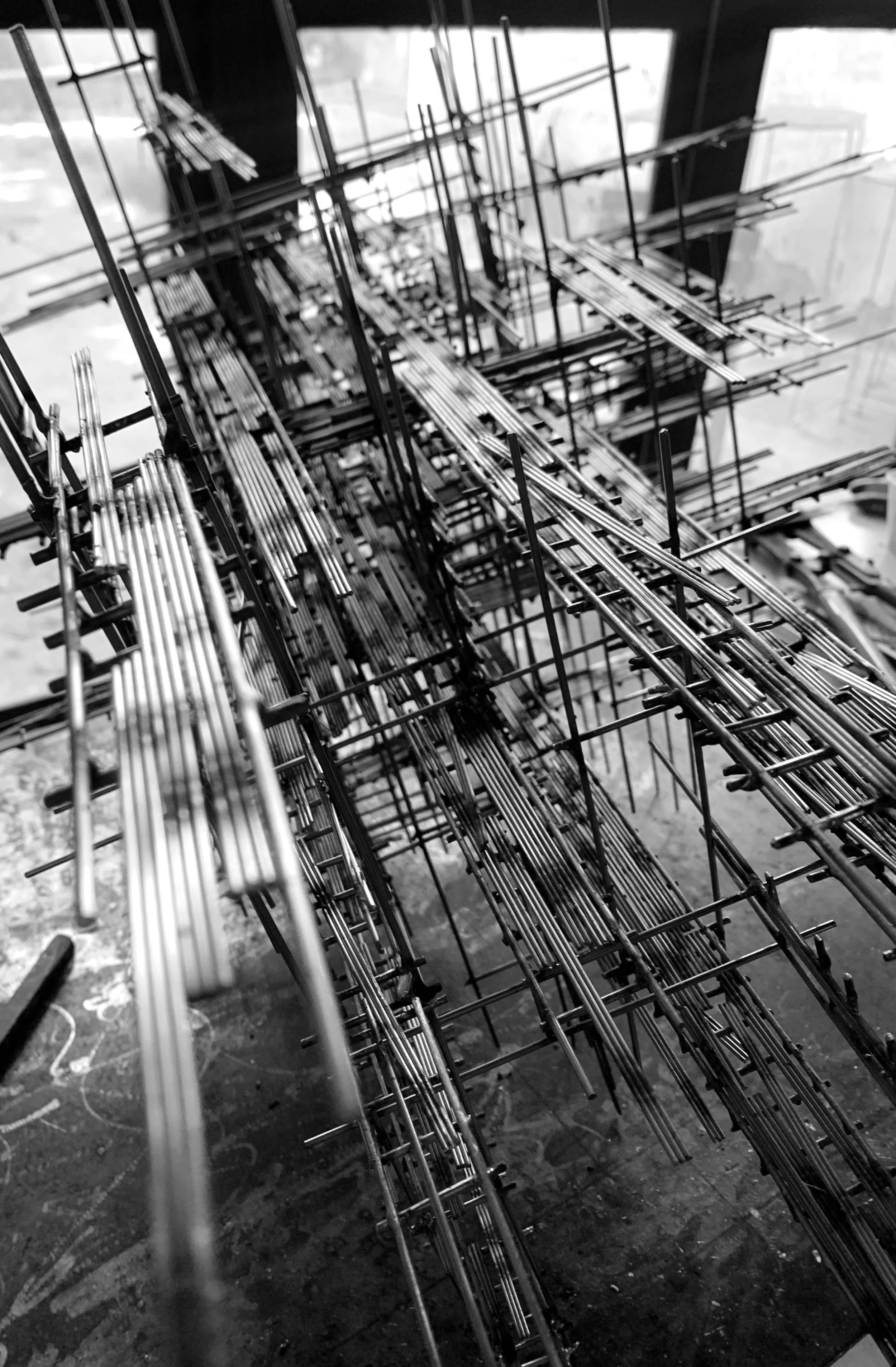Artist Kishwar Kiani
Congratulations to Kishwar Kiani for earning her place a Winner in the Boynes Monthly Art Award [May Edition]!
Who are you?
I’m a visual artist from Pakistan, whose practice revolves around the juxtaposition of order and chaos, and their coexistence within the framework of scaffoldings. I have studied, practiced and taught sculpture in a country where the field is considered a taboo. It may sound clichéd, but my passion for art was ingrained within me from as far back as I can recall. Making art is the one thing I have always been good at, and it provides me with a sense of purpose and fulfilment.
Over the years, my fascination has gradually shifted from an obsession with human anatomy to a deep admiration for architectural elements that surround us, particularly scaffolds. To me, scaffoldings embody the essence of work in progress and serve as a poignant reminder of the transient nature of existence. I find myself captivated by these structures, often spending considerable amounts of time simply admiring them.
“Chaos Starts With A C”
Charcoal Conte on Paper
By Kishwar Kiani
What inspired you to utilize charcoal as a medium?
Charcoal offers a fluid and malleable medium that captures the essence of my ideas and serves as a foundation for the subsequent stages of your sculptural process. By leveraging the erasable qualities of charcoal, I have the freedom to explore, experiment, and refine my artistic vision and this creates a balance between control and spontaneity. It enables me to continuously investigate the dynamics of my subject matter, adapting and evolving my work with each layer and modification. The ability to go back and forth in my process lends itself to expressive mark-making. This allows me to work in layers, gradually building up mass, form, and depth in my artwork.
Can you discuss the different mediums you use in your work?
I'm often traversing from charcoal to stainless steel and exploring everything in between. The choice of medium is influenced by the conceptual framework of my work, where at times the concept itself guides the selection of materials, while other times the materials inspire and shape the concept.
I approach each project with an open mind, always eager to explore new means and methods of giving life to my ideas. Sometimes the intention behind my work takes precedence over any particular medium. Therefore, I remain flexible and adaptable, allowing my concepts to guide me in choosing the most suitable medium to convey my artistic vision.
In the past I have worked with balsa wood, clear epoxy resin, UV pigments, paper, and my current focus on stainless and mild steel. By not limiting myself to a single medium I am constantly evolving and expanding my artistic repertoire, nurturing a sense of curiosity and a willingness to learn and grow as an art practitioner.
Installation of 'Chaos Starts with a C' at South London Gallery
By Kishwar Kiani
How would you describe your work?
My work inquires the taboos and societal expectations surrounding women's behaviour in public, particularly relating to vanity, acne scars, and body posture. It aims to explore the pressure on women to conform to certain beauty standards and the consequences of not meeting those expectations.
The subject here is deliberately sitting in a crouching position that conveys a sense of discomfort, unease, and rebellion against societal norms. The acne scars that adorn my subject’s appearance aims to challenge the notion that they are undesirable or unattractive.
“Untitled”
Charcoal on Paper
By Kishwar Kani
Can you discuss the inspiration and thought process behind your winning work?
I wanted to spark conversations about self-acceptance and challenge the unrealistic expectations placed upon individuals, particularly women, by society. The subject of this particular work, a close friend of mine, had been profoundly conscious and almost ashamed of her acne scars, as if she were personally responsible for their presence. In reality, these scars are a natural part of life, and she bears no blame for their existence. Unfortunately, contemporary society often leads women to believe that they are at fault for not conforming to narrow beauty standards.
The motivation behind creating this work also probes into the concept of beauty being subjective, as it is in the eye of the beholder. Personally, I view these acne marks not as blemishes, but as symbols of the individual's unique journey. They tell a story of resilience and growth, rather than being flaws to be hidden or stigmatized.
Through my work, I hoped to encourage viewers to reconsider their perspectives on beauty, to recognize the harmful impact of societal expectations, and to foster a more inclusive and compassionate understanding of self-acceptance. In essence, the scale of the drawing was a deliberate choice aimed at amplifying the impact of the artwork and it played a pivotal role in conveying the intended message. It allowed for a heightened focus on the acne marks, drawing attention to their significance and challenging societal perceptions of beauty. It provided a platform for these marks to be celebrated, making a bold statement that demanded attention and contemplation within a gallery setting. I strongly believed that if the artwork had been created on a smaller scale, it would not have had the same impact on viewers.
“Damaged Goods”
Charcoal on Paper
By Kishwar Kiani
Can you walk us through the technical steps of creating your winning work?
For me, art, regardless of its specific discipline, is fundamentally about problem-solving. Each piece presents its own unique set of challenges that I willingly embrace. These self-imposed obstacles become the very catalysts that ignite joy and satisfaction in resolving them.
I really do believe that a stick of charcoal possesses remarkable strength. I frequently employ paper stumps as blending tools, particularly during the initial draft stages of my drawings. Additionally, I find myself relying on the tactile sensitivity of my fingertips. Once I have established a solid under drawing, incorporating various vantage points and engaging in meticulous cross-referencing, I embark on the process of developing forms and features, layer by layer.
This layering technique adds complexity and dimensionality to my work and amplifies its emotive quality. It also allows me to refine and redefine elements as I progress, enabling me to constantly reassess and make informed decisions. As I progress to the later stages of my drawings, particularly when focusing on intricate details, I find the use of a mahl stick to be incredibly helpful. Its presence becomes instrumental in maintaining a clean and controlled working surface.
“Damaged Goods” (Process)
Charcoal on Paper
By Kishwar Kiani
What do you hope to communicate to an audience with your work?
With this artwork, my intention is to provoke viewers to question their perception of beauty and challenge the established societal standards of what is deemed beautiful. I aim to create a drawing that challenges preconceived notions and prompts individuals to re-evaluate their understanding of beauty, which has been shaped by cultural influences over time. By pushing the boundaries and defying conventional beauty ideals, I hope to inspire a deeper exploration and contemplation of the diverse aspects of beauty that exist beyond traditional norms.
By highlighting and celebrating the acne scars of my subject, as well as the unconventional posture in which she is seated, I aim to confront and challenge societal standards of beauty and etiquette. By glorifying these perceived imperfections, I aim to shift the narrative and encourage viewers to embrace a more inclusive and accepting understanding of beauty.
Through my art, I hope to inspire individuals to question the established norms and recognize the inherent beauty that lies within uniqueness, authenticity, and the courage to defy societal expectations. I want to create a space where acne scars and unconventional postures are celebrated as symbols of strength, resilience, and individuality.
“296 and Counting”
Stainless Steel
By Kishwar Kiani
Can you talk about your biggest learning experience during the process of creating your work?
One of the most significant lessons I learned throughout the process of creating this artwork was never to lose sight of the big picture. This project marked my first endeavour at such a large scale, presenting its own unique set of challenges. Initially, the portrait featured a white background, but in order to emphasize the subject's acne, I made the decision to change it to a charcoal black background. While this seemed like a simple adjustment, it turned into a monumental task as it necessitated a revaluation and reworking of all the shadows and highlights on the face.
The shift in background required careful consideration of the overall composition and the impact it would have on the subject's portrayal. Filling in the background alone proved to be a time-consuming process that required patience and precision.
It taught me the importance of considering the larger context and how seemingly minor changes can have a profound effect on the overall composition. This lesson reinforced the need to maintain a clear vision of the final artwork while also being adaptable and open to adjustments that enhance its intended message.
“296 and Counting” (Closeup)
Stainless Steel
By Kishwar Kiani
Can you discuss your biggest success since starting your artistic journey?
As a Muslim artist, I have embarked on a challenging journey to pursue sculpture as both a subject of study and a practice, despite the prevailing societal taboos surrounding this field in my country. It has not been an easy path to tread. Establishing my own metal workshop in an environment where women are rarely associated with traditionally male-dominated jobs, such as welding, presented significant obstacles that I had to overcome. I had to navigate through the biases and scepticism that arose from those who believed that such pursuits were not appropriate for women. I consider this as a feather in my cap because despite these hurdles, I remained committed to my artistic vision and the pursuit of my craft. And the pursuit of my artistic passion serves as a testament to the determination required to break through such societal barriers.
“Forcing House”
Stainless Steel
By Kishwar Kiani
Can you give us a piece of advice you wish you had known at the start of your career?
In hindsight, I realize now that I may have been unaware or overlooked many art opportunities, resulting in a lot of backfall. Looking back, I wish I had cultivated the discipline to engage in my artistic practice every day, especially during my younger years. Nonetheless, I recognize my growth in the past few years, and I now strive to make the most of the time I do have on my hands and I actively seek out opportunities that come my way.
“Exhibit B”
Mild Steel (Displayed at Camberwell College of Arts)
By Kishwar Kiani
What projects are you working on currently?
For a considerable period, I felt as if I possessed the touch of King Midas, yet instead of gold, it was order that seemed to follow in my wake. Through the medium of scaffolds, I am currently trying to create a temporary harmony between order and chaos by meticulously assembling piles of stainless-steel metal poles. However, in my pursuit to strike a delicate balance between these contrasting forces, I chose to manipulate time itself.
The welded stainless-steel structures I create serve as provocative entities, challenging viewers to discern the fine line that separates order from chaos. Are these two concepts truly distinct, or could they possibly intertwine and coexist? Such questions reverberate through the intricacies of my art. Viewers are prompted to question their preconceived notions and explore the dynamic/fluid relationship between order and chaos and embrace the inherent ambiguity that resides within these concepts.
Sneak Peek of current project
By Kishwar Kiani
What is your dream project or piece you hope to accomplish?
One day, I envision my dream project taking shape within the vast expanse of the Turbine Hall at Tate Modern. This ambitious endeavour would involve scaffolds reaching up to support the towering roof, symbolizing both strength and decay as they gradually crumble along the walls.
The scale of this installation presents a significant challenge, as it demands substantial investments of time and resources. Both the size of the work and the associated costs make it a formidable undertaking. However, I am undeterred by this challenge, as I believe that the magnitude of the project will ultimately be a testament to its impact and significance.
I hold onto the aspiration that one day I will showcase my work in the renowned Turbine Hall, an iconic space that has housed monumental works by esteemed artists such as Doris Salcedo and Olafur Eliasson.
“Stack”
Watercolor on Paper, Precision Cutting
By Kishwar Kiani
As a winner, do you have any advice for artists who want to submit to awards, competitions, residencies, etc.?
In my view, it is important for artists to maintain a curated list of galleries, residencies, art prizes, and grants that resonate with their artistic practice. By doing so, artists can align their aspirations and intentions with these opportunities. It is crucial to embrace the application process without being discouraged by the outcome. I think ultimately, the journey of creating art and deepening one's understanding of their own practice is the true essence of artistic pursuit.
“The race is long, but in the end it’s only with yourself” - Baz Luhrman
“She Brought Me Chaos”
Brazed Stainless Steel
By Kishwar Kiani
Lastly, I like to ask everyone what advice they would give to their fellow artists, what is your advice?
Just keep swimming. Trust me there is no other way.
To view more of Kishwar Kiani











